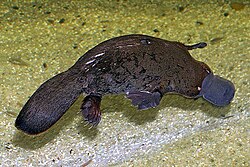鴨嘴
Appearance
Chinese
[edit]| duck | mouth | ||
|---|---|---|---|
| trad. (鴨嘴) | 鴨 | 嘴 | |
| simp. (鸭嘴) | 鸭 | 嘴 | |
Pronunciation
[edit]- Mandarin
- (Standard Chinese)+
- Hanyu Pinyin:
- Zhuyin: ㄧㄚ ㄗㄨㄟˇ
- Tongyong Pinyin: yazuěi
- Wade–Giles: ya1-tsui3
- Yale: yā-dzwěi
- Gwoyeu Romatzyh: iatzoei
- Palladius: яцзуй (jaczuj)
- Sinological IPA (key): /jä⁵⁵ t͡su̯eɪ̯²¹⁴⁻²¹⁽⁴⁾/
- (Standard Chinese)+
- Cantonese
- (Standard Cantonese, Guangzhou–Hong Kong)+
- Jyutping: aap3 zeoi2
- Yale: aap jéui
- Cantonese Pinyin: aap8 dzoey2
- Guangdong Romanization: ab3 zêu2
- Sinological IPA (key): /aːp̚³ t͡sɵy̯³⁵/
- (Standard Cantonese, Guangzhou–Hong Kong)+
Noun
[edit]鴨嘴
- bill of a duck
- (figurative, informal) Short for 鴨嘴器/鸭嘴器 (yāzuǐqì, “speculum used in gynaecological examinations”).
Derived terms
[edit]Japanese
[edit]

| Kanji in this term | |
|---|---|
| 鴨 | 嘴 |
| かも(の) Jinmeiyō |
はし Hyōgai |
| kun'yomi | |
Etymology
[edit]Compound of 鴨 (kamo, “duck”) + の (no, possessive particle) + 嘴 (hashi, “bill, beak”). The の (no) is omitted in the spelling.
The platypus sense is a calque of English duck-billed platypus.
Pronunciation
[edit]- (Tokyo) かものはし [kàmó nóꜜ hàshì] (Nakadaka – [3])[1][2][3]
- (Tokyo) かものはし [káꜜmò nò hàshì] (Atamadaka – [1])[1][3]
- IPA(key): [ka̠mo̞ no̞ ha̠ɕi]
Noun
[edit]鴨嘴 or 鴨嘴 • (kamo no hashi)
- a platypus
- a. 2012, カモノハシペリーのテーマ (Perry the Platypus theme song):
- オー ペリー カモノハシペリー!
エージェントピーと呼びまえ
ペリー!
だからエージェントPだってのに
エージェントP!- Ō perī kamo no hashi perī!
ējento pī to yobimae
perī!
dakara ējento P datte noni
ējento P! - Oh, Perry, Perry the Platypus!
But you can call him Agent P
Perry!
I said you can call him Agent P
Agent P!
- Ō perī kamo no hashi perī!
- オー ペリー カモノハシペリー!
- a. 2012, カモノハシペリーのテーマ (Perry the Platypus theme song):
- Ischaemum aristatum var. glaucum, a kind of smutgrass or batiki bluegrass
Usage notes
[edit]As with many terms that name organisms, this term is often spelled in katakana, especially in biological contexts (where katakana is customary), as カモノハシ.
References
[edit]- ↑ 1.0 1.1 NHK Broadcasting Culture Research Institute, editor (1998), NHK日本語発音アクセント辞典 [NHK Japanese Pronunciation Accent Dictionary] (in Japanese), Tokyo: NHK Publishing, Inc., →ISBN
- ^ Kindaichi, Kyōsuke et al., editors (1997), 新明解国語辞典 [Shin Meikai Kokugo Jiten] (in Japanese), Fifth edition, Tokyo: Sanseidō, →ISBN
- ↑ 3.0 3.1 Matsumura, Akira, editor (2006), 大辞林 [Daijirin] (in Japanese), Third edition, Tokyo: Sanseidō, →ISBN
Further reading
[edit]Categories:
- Chinese lemmas
- Mandarin lemmas
- Cantonese lemmas
- Chinese nouns
- Mandarin nouns
- Cantonese nouns
- Chinese terms with IPA pronunciation
- Chinese terms spelled with 鴨
- Chinese terms spelled with 嘴
- Chinese informal terms
- Chinese short forms
- Japanese terms spelled with 鴨 read as かも
- Japanese terms spelled with 嘴 read as はし
- Japanese terms read with kun'yomi
- Japanese compound terms
- Japanese terms calqued from English
- Japanese terms derived from English
- Japanese terms with IPA pronunciation
- Japanese lemmas
- Japanese nouns
- Japanese terms with multiple readings
- Japanese terms spelled with jinmeiyō kanji
- Japanese terms spelled with hyōgai kanji
- Japanese terms with 2 kanji
- Japanese terms with usage examples
- ja:Monotremes
- ja:Andropogoneae tribe grasses

